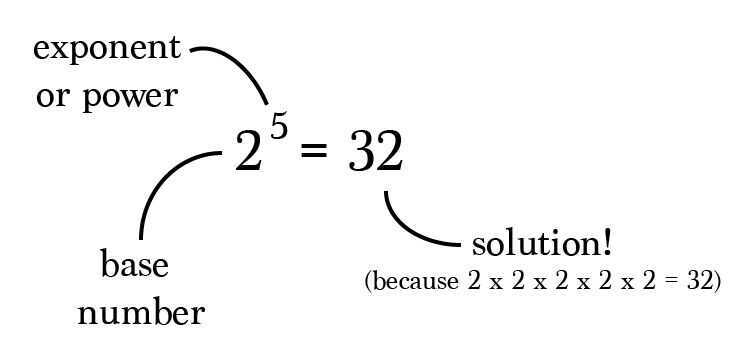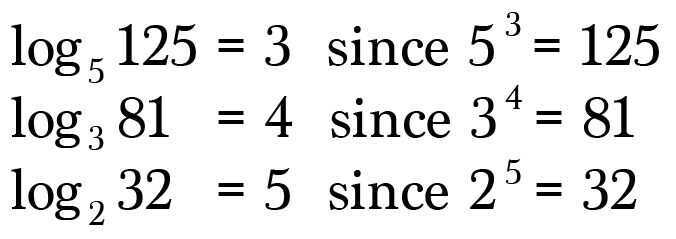2.7. Exponential & logarithms
-
Introduction to logarithms
-
Intro to logarithms
- Common Logarithm
- Natural Logarithm
-
Relationship between exponential and logarithms
-
Relationship between exponential and logarithms: Graphs
-
Relationship between exponential and logarithms: Tables
-
-
The constant e and the natural logarithm
- e and compound interest
- e as a limit
- Evaluating natural logarithm with calculator
-
Properties of logarithms
- The product rule = log
BA + logBC = logB(A.C) - The quotient rule = log
BA - logBC = logB(A/C) - The power rule = A . log
BC = logB( C^A^ ) - Change of base rule= log
BA = logCA / logCB
- The product rule = log
-
The change of base formula for logarithms
-
Solving exponential equations with logarithms
-
Solving exponential models
-
Graphs of exponential functions
-
Graphs of logarithmic functions
-
Logarithmic scale
- Richter Scale (is a logarithmic scale)
- Benford's Law
Exponentiation
Exponentiation is a mathematicaloperation, written asb^n^, involving two numbers, the baseband the exponentn. When n is a positive integer, exponentiation corresponds to repeated multiplication of the base: that is,*b^n^*is the product of multiplying n bases

The number we multiply with itself is called the base.The number of times we multiply it with itself is called the power or exponent.
Properties of exponents
-
Product of powers property
x^a^⋅x^b^ = x^(a+b) -
Power of a power property
(x^a^)^b^ = x^a*b^ -
Power of a product property
(x.y)^a^ = x^a^ * y^a^ -
Quotient of powers property
x^a^/x^b^ = x**^a-b^** , x≠0 -
Power of a quotient power
(x/y)^a^ = x^a^/y^a^ , y≠0 -
Identity Exponent
x^0^ = 1, x≠0 -
Negative Exponent
x **^-a^** = 1/x^a^ , x≠0 -
Square root of exponents
√x =x**^1/2^**
Exponentiation by Squaring
- Square and Multiply algorithm
- Binary Exponentiation
https://www.youtube.com/watch?v=BfNlzdFa_a4&ab_channel=mCoding
References
https://medium.com/i-math/understanding-logarithms-and-roots-2fee92c3317f# Logarithms
thelogarithmis the inverse operation to exponentiation, just as division is the inverse of multiplication. That means the logarithm of a number is the exponent to which another fixed number, the base, must be raised to produce that number. What if we wanted to solve for the exponent in an exponential equation? In other words, we want to reverse the exponentiation. For example, what is the solution to this problem?
Since we've memorized the common powers and roots, we easily identify the solution as 2 since 6 to the power of 2 is 36. Writing a question mark in the equation isn't formal mathematics, instead we'll write the above expression usinglogarithm notation, orlogfor short.
Read: "the log, base six, of thirty-six is2."
The terminology:
Another way to look at this is to ask,
"How many sixes need to be multiplied together to get36?"
Algorithm solves for the number of repeated multiplications. Simple as that. Here are a few more examples.

Special logarithms
While the base of a logarithm can have many different values, there are two bases that are used more often than others. Specifically, most calculators have buttons for only these two types of logarithms. Let's check them out.
The common logarithm
Thecommon logarithmis a logarithm whose base is10("base-10logarithm"). When writing these logarithms mathematically, we omit the base. It is understood to be10.
log10(x)=log(x)
The natural logarithm
Thenatural logarithmis a logarithm whose base is the numbere("base-e logarithm"). Instead of writing the base ase, we indicate the logarithm withln.
loge(x)=ln(x)
This table summarizes what we need to know about these two special logarithms:
| Name | Base | Regular notation | Special notation |
|---|---|---|---|
| Common logarithm | 10 | log10(x) | log(x) |
| Natural logarithm | e | loge(x) | ln(x) |
While the notation is different, the idea behind evaluating the logarithm is exactly the same!
Mathematical Constant -> Euler's Number -> e = 2.71828
e is the epitome of universal growth
Like π, e is irrational, it is not ratio of integers Like π, e is transcendental, it is not root of any non-zero polynomial with rational coefficients. Sequence - A001113 in OEIS (On-Line Encyclopedia of Integer Sequences, Sloane's) The mathematical constant e, is the base of natural logarithm.
Steps for sketching a graph for any logarithm
-
Determine the correct shape of the graph
-
Determine the position of its asymptote
-
Find two points on the graph For finding the shape, recall what graph looks like so it can be reduced from that.
Facts
- Numbers greater than 0 and less than 1 have negative logarithms.
To avoid the need for separate tables to convert positive and negative logarithms back to their original numbers, a bar notation is used: